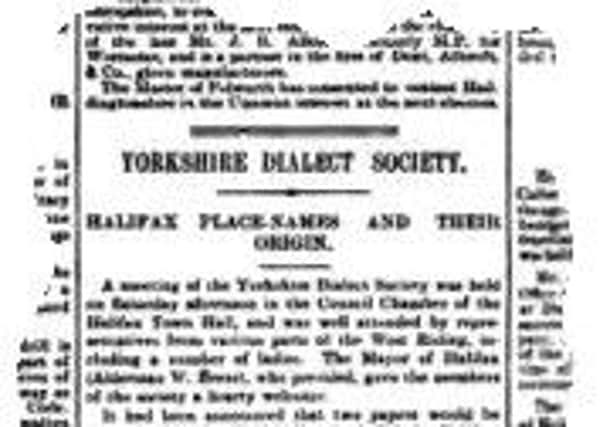On this day in Yorkshire
This article contains affiliate links. We may earn a small commission on items purchased through this article, but that does not affect our editorial judgement.


March 17, 1902
A meeting of the Yorkshire Dialect Society was held on Saturday afternoon in the Council Chamber of the Halifax Town Hall, and was well attended by representatives from various parts of the West Riding, including a number ladies. The Mayor of Halifax (Alderman W. Brear), who presided, gave the members of the society a hearty welcome.
It had been announced that two papers would read, one by Mr Charles Crossland FLS, Halifax, and the other by the Rev Thomas Clarke, Bradford, but Mr S Philip Unwin (chairman of the Council of the society) announced that it had been thought wise, in justice to both essayists, to devote one afternoon to each paper, and the Rev T. Clarke had kindly consented to postpone the reading of his paper on “The Sounds and Forms of the North-country Folk-Speech” to a future meeting.
Advertisement
Hide AdAdvertisement
Hide AdMr Crossland’s subject was “Some Place-Names in the Parish of Halifax, Considered in Relation to their Natural Features.” He commenced by giving a description of the parish, which contains 129 square miles, and its physical features, and said that the great inequalities of land surface had exercised a marked influence on place nomenclature. There were hundreds of place-names in the parish which owed their origin to causes other than the surrounding natural features, but these he left out of consideration. On the six-inch Ordnance map there were fewer than 3,500 distinct place-names, of which not two were alike, in addition, of course, to many duplicates found in different parts of the parish. He grouped the names he dealt with under three heads, those arising from the hills, the streams and the valleys.
The map contained 220 place-names in which the word “hill” occurred - rather a large family; so large, indeed, that the term “hill,” by itself, was meaningless, and it was necessary that each one should have an adjective wedded to it to make it of value as a distinct place-name. Thus there was Snow Hill, where the snow remained longest (akin to Snaefell); Stone Hill, where big stones were got: Heather Hill, heather-clad, etc. Some hills were named from their relative position to certain points, or to adjoining places; some from their tenants or owners, as Sam Hill, Kit Hill. Toothill, he thought, derived its name as a hill on which people in former ages would congregate to hear a proclamation or attend a council, and the name was associated with the blowing of a horn.
lt was also safe to hazard an explanation of Crow Hill, of which there were two, at Sowerby and Midgley, respectively, and each of them points of great prominence.
They were doubtless utilised for scouting or “crow” purposes in turbulent times. Beacon Hill derived its name from its use for signalling purposes. The varying features of the hill tops and sides had originated quite a number place-names, such as heights, pikes, points, bridges, edges, nabs, soars, scouts, rocks, stones, shelves, cliffe, brows, snicks, nook, and falls. “Slack” was an expressive word signifying a slight depression between two hills.
Advertisement
Hide AdAdvertisement
Hide AdOf names derived from the streams there were two classes - those arising from freely flowing water, such as the sykes, dykes, streams, becks, brooks, and rivers; and those arising from the less easy-flowing water, which gave rise to the mosses, bogs, mires, and marshes.
Rishworth was at one time a district where the rushes delighted to grow. Carr was a Celto-Saxon word implying a wet place among shrubs. The name of the River Calder meant the woodland river.
The valleys conferred such names as holes, hollows, cloughs, lumbs. dens or denes and holmes. Most of the moorland hollows were called holes, and there were about sixty in the parish.
“Auf hole”* was an old form of “elf,” or fairy hollow. There were 160 cloughs or clefts in the hills. A “lumb” was usually a wooded portion of a clough.
Advertisement
Hide AdAdvertisement
Hide AdHolme was obtained from a Scandinavian term for flat land by the side of the river. Mytholm was middle-holme; but it was doubtful whether Hipperholme ever was a “holme.”
Mr John Lister considered the name to be a corrupt form of “ham “ (German, hein), meaning a settlement, and had found that in the thirteenth century the spelling of the name was “Hyperum.”
In conclusion, Mr Crossland said that in these place-names were preserved many features of the ever-changing language of the people. Most the good old names they had been considering were true to nature, for their forbears would never have named a place on a dry moor “Holme Lea” - (laughter) - but would take advantage of surrounding features and objects to furnish place-names.
Whilst many names spoke for themselves, and their origin was apparent, others were peculiar, such as Hagstocks, Sandy Pickle, Wiscombe Dandy. Each had its own history if it could be traced, but many might be contractions or corruptions of words which the tongues of the people had so twisted out shape to render them unrecognisable. t
Advertisement
Hide AdAdvertisement
Hide AdThe Rev Bryan Dale (Bradford) moved a vote of thanks to Mr Crossland for his interesting paper, which was seconded Mr John Metcalfe (Baildon), supported by Mr A. Whitley (Halifax) and Mr Philip Unwin, and cordially adopted. A vote of thanks to the Mayor of Halifax was also accorded.
To browse our historic pages online visit the British Newspaper Archive